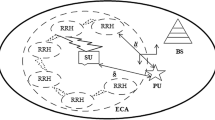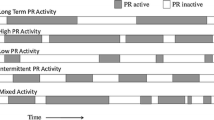Abstract
To exploit spectrum resources on a secondary basis, a Sensor Network Aided Cognitive Radio Network uses a wireless sensor network that assists a secondary cognitive radio network by providing information about the current primary spectrum occupancy. In this paper we determine the performance for different cell sizes when considering the costs for deployment of base stations in a secondary network that exploits spectrum holes identified by the wireless sensor network. The secondary base station is deployed co-located with a mobile primary network that uses a cellular reuse pattern with seven frequencies. Performance of the secondary system and impact on the primary system are mainly studied in terms of throughput, packet loss and coverage when using spectrum holes in the space, time and frequency domains. Especially, we find that the cell size and configured transmit powers for the secondary system are important for optimal system performance, and that smaller cell sizes and less expensive base stations for the secondary system are beneficial. The impact on primary system performance was found to be low, but that optimal tuning of the sensor network is important.






Similar content being viewed by others
Notes
Each single simulation takes more than 1 hour on an IBM cluster with dual quad core compute nodes Xeon L5420 / 2.5 GHz processors, each with 8 cores, 8 GB of memory and operating system linux Ubuntu Hardy Heron.
References
3GPP TSG-RAN-1 (2003). Effective sir computation for ofdm system-level simulations. Technical Report.
Axell, E., Larsson, E. G., & Danev, D. (2009). Capacity considerations for uncoordinated communication in geographical spectrum holes. Cognitive radio networks: Algorithms and system design. Physical Communication, 2(1–2), 3–9.
Braithwaite, C., & Scott, M. (2003). UMTS Network Planning and Development. Elsevier.
Damosso, E. (1999). COST 231. Digital mobile radio towards future generation systems. Final report, European Commission, EUR 18957. Brussels, Belgium. http://www.lx.it.pt/cost231.
FCC (2010). ET Docket No. 10-237. Technical Report.
Gastpar, M. (2004). On capacity under received-signal constraints. In: Proc 2004 Allerton conference.
Ghasemi, A., & Sousa, E. S. (2007). Fundamental limits of spectrum-sharing in fading environments. IEEE Transactions on Wireless Communications, 6(2), 649–658.
Grøndalen, O., et al. (2010). Scenario descriptions and system requirements. Technical Report.
Grøndalen, O., Lähteenoja, M., & Grønsund, P. (2011). Evaluation of business cases for a cognitive radio network based on wireless sensor network. In: New frontiers in dynamic spectrum access networks (DySPAN), 2011 IEEE symposium. Aachen, Germany.
Hayar, A., et al. (2011). Performance of sendora networks. Technical Report.
Hoven, N., & Sahai, A. (2005). Power scaling for cognitive radio. In: Wireless networks, communications and mobile computing, 2005 international conference (vol. 1, pp. 250–255).
ITU (1997). Guidelines for evaluations of radio transmission technologies for imt-2000. Technical Report.
Larsson, E., & Skoglund, M. (2008). Cognitive radio in a frequency-planned environment: Some basic limits. IEEE Transactions on Wireless Communications, 7(12), 4800–4806.
Mercier, B., et al. (2009). Sensor networks for cognitive radio: Theory and system design. In: ICT mobile summit. Stockholm, Sweden.
Sendora project. http://www.sendora.eu/.
IEEE standard for local and metropolitan area networks part 16 (2006) Air interface for fixed and mobile broadband wireless access systems amendment 2: Physical and medium access control layers for combined fixed and mobile operation in licensed bands and corrigendum 1. IEEE Std 802.16e-2005 and IEEE Std 802.16-2004/Cor 1-2005 (Amendment and Corrigendum to IEEE Std 802.16-2004), URL: http://ieeexplore.ieee.org/stamp/stamp.jsp?tp=&arnumber=1603394&isnumber=33683
Tandra, R., Sahai, A., & Mishra, S. (2009). What is a spectrum hole and what does it take to recognize one? Proceedings of the IEEE, 97(5), 824–848.
The wimax forum system level simulator. http://code.google.com/p/ns2-wimax-awg/.
Wang, C. X., Hong, X., Chen, H. H., & Thompson, J. (2009). On capacity of cognitive radio networks with average interference power constraints. IEEE Transactions on Wireless Communications, 8(4) 10.
Acknowledgements
Part of the research leading to these results was performed in the SENDORA project (FP7/2007-2013, under grant agreement n° 216076).
Author information
Authors and Affiliations
Corresponding author
Rights and permissions
About this article
Cite this article
Grønsund, P.R., Grøndalen, O. Comparison of Cell Sizes for Cost Efficient Deployment of a Sensor Network Aided Cognitive Radio System. J Sign Process Syst 69, 95–104 (2012). https://doi.org/10.1007/s11265-011-0636-4
Received:
Revised:
Accepted:
Published:
Issue Date:
DOI: https://doi.org/10.1007/s11265-011-0636-4




